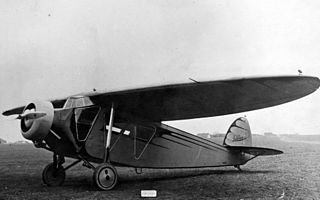
The PZL.23 Karaś was a Polish light bomber and reconnaissance aircraft designed in the early 1930s by PZL in Warsaw.

The PZL P.7 was a Polish gull wing monoplane fighter aircraft designed in the early 1930s at the PZL factory in Warsaw. It was the main fighter of the Polish Air Force between 1933 and 1935. The PZL P.7 was replaced in Polish service by its follow-up design, the PZL P.11c. More than 30 PZL P.7 fighters remained in service during the Invasion of Poland, scoring several kills despite its obsolescence.

The PWS-24 was a Polish single-engine passenger aircraft for 4 passengers, built in PWS factory, used from 1933 to 1936 by LOT Polish Airlines. In spite of its limited capacity, it was the only series-built airliner of domestic design ever used by the LOT.

The PWS-33 Wyżeł was a Polish twin-engined military trainer aircraft from a period before World War II constructed by Podlaska Wytwórnia Samolotów or PWS. Although destined for production it got no further than the prototypes before Poland was invaded.

PZL.19 was a Polish sports aircraft built in 1932 in the PZL works. Ordered by the Ministry of Communications, it was specifically designed for the upcoming Challenge 1932 contest held that year in Germany.

The PZL.44 Wicher (gale) was a prototype of 14-seat, twin-engine Polish airliner, built in the Państwowe Zakłady Lotnicze (PZL) in 1938. It was to compete with the DC-2 and Lockheed Super Electra.

The PZL P.6 was a Polish fighter, designed by the engineer Zygmunt Puławski, manufactured by PZL state-owned factory. It remained a prototype.

PZL.26 was a Polish sports plane built in 1934 in the PZL works. Ordered by the Ministry of Defence, it was specifically designed for the upcoming Challenge 1934 International Touring Aircraft Contest.
The PZL M-24 Dromader Super is a single engine agricultural aircraft, developed in the 1980s by the WSK-Mielec from the PZL-Mielec M-18 Dromader. It did not progress beyond the prototyping stage.

The Lublin R-X was a Polish single-engined, two seat liaison aircraft, built in 1929 in the Plage i Laśkiewicz factory in Lublin. Seven were completed, two of them prototypes. Four served with Polish air regiments and another made several notable long flights and tours.

The Lublin R-XVI was a Polish passenger and air ambulance aircraft, designed in the 1930s in the Plage i Laśkiewicz factory in Lublin and built in a small series.
The Lublin R-XX was the Polish torpedo bomber floatplane, designed in the early 1930s in the Plage i Laśkiewicz factory in Lublin. It remained a prototype.

PZL.12 (PZL-H) was a prototype of a Polish amphibious flying boat designed and built in 1931 by Zygmunt Puławski, a pioneering Polish designer. He was killed in a crash involving this design.

The PZL.16 was a Polish passenger aircraft, designed in the early 1930s in the PZL in Warsaw. It remained a prototype.

The PZL Ł.2 was the Polish Army cooperation and liaison aircraft, built in 1929 in the Polskie Zakłady Lotnicze (PZL) in Warsaw. Only a small series of 31 aircraft, including prototype, were made, and used by the Polish Air Force in the 1930s. The aircraft was known in Poland for accomplishing of a long-distance tour around Africa in 1931.

The Bartel BM 6 was a Polish biplane trainer fighter aircraft of 1930. It did not advance beyond the prototype stage.

The PZL P.1 was a Polish fighter, designed by the engineer Zygmunt Puławski, manufactured by the PZL state-owned factory. It remained a prototype, but it was the first of the Polish PZL gull wing fighter series, leading to the PZL P.7, PZL P.11 and PZL P.24.

The PWS-20 was a Polish single-engine high-wing 8 passenger airliner, built in the PWS factory and when it made its first flight in 1929 it became the first Polish-designed transport aircraft to fly.

The PZL M-17 "Duduś Kudłacz" was a Polish twin-boom pusher general aviation and trainer aircraft of 1977, which remained a prototype.

The Lublin R-XI was the Polish passenger plane for 4 passengers, designed in 1930 in the Plage i Laśkiewicz factory in Lublin, that remained a prototype.


















